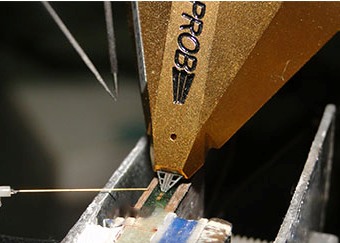4.1 Microring laser sources
Microring Lasers (MRL) have been proposed as an alternative optical source to edge-emitting lasers. In contrast with the latter, MRLs do not require mirrors or distributed Bragg gratings for optical feedback, a necessary property in order to achieve the lasing condition. In particular, for semiconductor materials, the high index contrast allows the fabrication of very small bending radii with minimal losses which leads to significantly compact devices with footprints suitable for very large scale integration (VLSI). Moreover, their large third-order nonlinearities, enhanced by the resonance effect, makes them suitable for realizing complex all-optical functions like optical logical gates and memories. In addition, MRLs, unlike edge emitting lasers, are travelling wave in nature which means that they do not suffer from spatial hole burning, a major spectral purity degradation factor in standing wave lasers like Fabry-Perot cavities. Therefore, MRLs can achieve significantly high side mode suppression ratios without any wavelength selection mechanism. For all the aforementioned reasons MRLs have emerged as excellent fundamental building blocks for the development of opto-electronic integrated circuits (OEICs).
Our group has been at the forefront of the MRLs’ development and was actively engaged in the relative research by participating in the EU project WAPITI. The active-passive integration technology developed within the scope of the WAPITI project produced interesting devices that include active ring cavities, vertically coupled with passive bus waveguides through a wafer bonding process. A few highlights of the group’s record and researched applications are:
- MRLs operating in Continuous Wave (CW) mode with very low Intensity Noise (<-150dB/Hz) and Phase Noise with measured linewidth down to 600KHz.
- Injection current tunable double ring lasers with side mode suppression exceeding 35dB and wavelength range over 40nm.
- Optical amplification at 10 Gb/s with 10dB on chip amplification.
- Modulation rates up to 7Gb/s have been recorded corresponding in error free (BER<10-12) for back to back measurements.
- Error-free transmission through a 50km optical fiber at 2.5Gb/s showing the potential use of these versatile sources in metro and access optical networks.
Related projects:
- PENED 2003
- WAPITI
- FAST-DOT
Significant publications:
- A. Kapsalis, U. Troppenz, M. Hamacher, H. Heidrich and D. Syvridis, “7Gb/s Direct Modulation of Vertically Coupled Microring Lasers,” OFC 2008, 24-28 February 2008, San Diego, California, USA
- A. Kapsalis, I. Stamataki, S. Mikroulis, D. Syvridis, M. Hamacher, “Widely Tunable All-Active Micro-Ring Lasers”, IEEE Phot. Techn. Lett., vol. 18, no. 24, pp. 2641-2643 (2006)
- I. Stamataki, S. Mikroulis, A. Kapsalis, D. Syvridis, “Investigation on the Multimode Dynamics of InGaAsP/InP Microring Lasers”, IEEE Journal of Quant. Electronics, vol. 42, no. 12, pp. 1266-1273(2006)
- A. Kapsalis, H. Simos, D. Syvridis, M. Hamacher, H. Heidrich, “Tunable Wavelength Conversion using Cross Gain Modulation in a Vertically Coupled Microring Laser,” IEEE Phot. Techn. Lett., vol. 21, no. 21, pp. 1618-1620 (2009)
- A. Kapsalis, D. Syvridis, M. Hamacher, H. Heidrich, “Broadly Tunable Laser using Double-Rings Vertically Coupled to a Passive Waveguide”, IEEE Journal of Quantum Electron., vol. 46, no. 3, pp. 306-312 (2010)
- A. Kapsalis, I. Stamataki, C. Mesaritakis, M. Hamacher, H. Heidrich, “Design and Experimental Evaluation of Active-Passive Integrated Microring Lasers: Threshold Current and Spectral Properties,” IEEE Journal of Quantum Electron Vol.47, no.12, pp.1557-1564, Dec. 2011
- A. Kapsalis, I. Stamataki, C. Mesaritakis, M. Hamacher, H. Heidrich, “Design and Experimental Evaluation of Active-Passive Integrated Microring Lasers: Noise Properties,” IEEE Journal of Quantum Electron. Vol. 48, no.2, pp.99-106, Feb. 2012, Special issue on Optoelectronic Devices.

